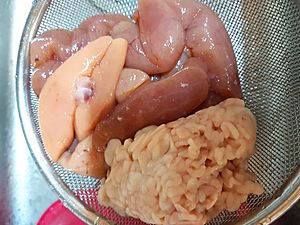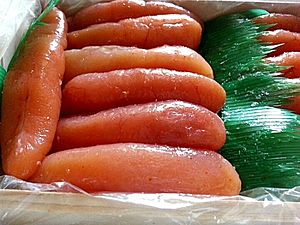Pollock roe facts for kids
Quick facts for kids Alaska pollock roe |
|||||||
|---|---|---|---|---|---|---|---|

Alaska pollack's liver, roe, and milt
|
|||||||
| Korean name | |||||||
| Hangul | 명란 | ||||||
| Hanja | 明卵 | ||||||
| Literal meaning | Alaska pollock roe | ||||||
|
|||||||
| Japanese name | |||||||
| Kanji | 鱈子 | ||||||
| Kana | たらこ | ||||||
|
|||||||
| Russian name | |||||||
| Russian | икра минтая | ||||||
| Romanization | ikra mintaya | ||||||
Pollock roe, also known as pollack roe, is the name for the eggs (called roe) of a fish called the Alaska pollock. Even though it's called "pollock," this fish is actually a type of cod. Salted pollock roe is a very popular food in Korea, Japan, and Russia. It's often used in many different dishes.
Contents
Names for Pollock Roe
People in different countries have special names for pollock roe. These names often tell us something about the fish or its eggs.
Korean Names
In Korea, pollock roe is called myeongnan (명란,明卵). When it's salted and prepared as a dish, it's called myeongnan-jeot (명란젓). This dish is a type of jeotgal, which means "salted seafood."
The word myeongnan comes from two parts:
- Myeong (명,明) comes from myeongtae (명태,明太), which is the Korean word for Alaska pollock.
- Ran (란,卵), also said as nan, means "egg" or "roe."
So, myeongnan literally means "pollock eggs." Since jeot means "salted seafood," myeongnan-jeot means "salted pollock roe."
Japanese Names
In Japan, pollock roe is often called tarako. Another popular name is mentaiko or karashi-mentaiko.
- Mentaiko comes from the Korean word myeongtae (meaning Alaska pollock) and the Japanese word ko (子), which means "child" or "roe."
- The Japanese name for Alaska pollock is suketōdara (介党鱈).
- The word tara (Tara (鱈)) means "cod" in Japanese. So, tarako (鱈子) literally means "cod roe." It usually refers to smaller, salted roe sacs.
Russian Names
In Russia, pollock roe is called ikra mintaya (икра минтая). This name is also used for the salted roe dish.
- The Russian word ikra (икра) means "roe."
- Mintaya (минтая) comes from mintay (минтай), which means Alaska pollock.
- Like the Japanese "mentai," the Russian "mintay" also came from the Korean word myeongtae.
History of Pollock Roe as Food
People have been eating pollock roe for a long time in different parts of the world.
In Korea
Koreans have enjoyed pollock roe since the Joseon era, which was a kingdom that lasted from 1392 to 1897. One old record from 1652 mentions pollock roe. It talks about officials being questioned for bringing pollock roe instead of cod roe. This shows how important fish roe was as food. A cookbook from the 1800s, called Siuijeonseo, even has a recipe for salted pollock roe.
In Japan
An old Japanese book from 1696 mentions that Alaska pollock roe was used as food in the northern parts of Japan.
The popular Japanese dish mentaiko actually came from the Korean myeongnan-jeot. A man named Toshio Kawahara was born in Busan, Korea, when Japan ruled Korea. After World War II, he started the oldest mentaiko company in Japan. He changed the Korean myeongnan-jeot a little bit to fit Japanese tastes. He then introduced it to Japan as "Karashi mentaiko," which is now very popular. A milder, less spicy version of this dish is called tarako in Japan.
Salted Pollock Roe Dishes
 |
|
| Alternative names | Myeongnan Myeongnan-jeot Tarako Mentaiko Ikra mintaya |
|---|---|
| Type | Jeotgal |
| Course | Banchan |
| Place of origin | Korea |
| Associated national cuisine | Korean cuisine Japanese cuisine Russian cuisine |
| Main ingredients | Roe of Alaska pollock |
Salted pollock roe is a delicious food enjoyed in many ways.
In Korea
Traditionally, myeongnan-jeot was made before the winter solstice (a special day in winter). The whole sacs of Alaska pollock roe are carefully washed with salt water. Then, they are salted in a bamboo basket. The amount of salt used can vary. After 2–3 days, the salted roe is drained. Then, it's marinated for at least a day with fine chilli powder (called gochutgaru) and chopped garlic. Myeongnan-jeot is often served with sesame seeds or a few drops of sesame oil.
Myeongnan-jeot is a common banchan (side dish) in Korea. It's also an anju (food served with alcoholic drinks). You can find it raw, dried, or cooked. It's used in many dishes, like gyeran-jjim (steamed egg) and bokkeum-bap (fried rice). Recently, it's even been used in Korean-style Italian pasta dishes.
Myeongnan-jeot is a special food from South Hamgyong Province in North Korea. It's also a specialty in Gangwon Province and Busan in South Korea.
In Japan
Mentaiko, which came from Korean myeongnan-jeot, is very common in Japan. It comes in many flavors and colors. You can find it at airports and train stations. It's usually eaten with onigiri (rice balls) or by itself with sake (Japanese rice wine). A popular type is karashi mentaiko, which is spicy. It's a special product from the Hakata area of Fukuoka City. A milder version is called tarako (鱈子).
Recently, mentaiko pasta has become very popular in Japan. Mentaiko is mixed with butter or mayonnaise to make a sauce for spaghetti. Thin strips of Nori (seaweed) and Shiso leaves are often sprinkled on top.
Mentaiko was even voted Japan's number one side dish in a Japanese magazine called Shūkan Bunshun.
Tarako is served in several ways:
In the past, tarako was dyed bright red. But now, because people are worried about food coloring, this is rarely done. In Kyūshū, tarako is often served with red chili pepper flakes.
In Russia
In Russia, pollock roe is eaten as a spread for sandwiches. It's sold in cans and looks like a smooth paste. This is because the eggs are very small, and oil is added to the mixture.
Images for kids
-
Myeongnan-jeot-muchim (salted pollock roe salad)
-
Myeongnan-jeot-gyeran-mari (rolled omelette with salted pollock roe)
-
Myeongnnan-jeot in jjigae (stew)
-
Myeongnan-jeot pizza
-
Mentaiko-chazuke
-
Mentaiko spaghetti
See also
 In Spanish: Hueva de abadejo para niños
In Spanish: Hueva de abadejo para niños















